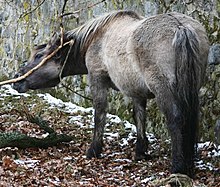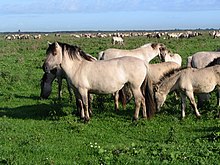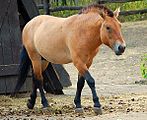Dun (horse)
A dun is a horse with a light body, dark long hair (mane, tail) and dark wild color markings ( eel line , possibly also shoulder cross and zebrification). The color is determined by the wild type - allele caused on the Dun locus. In a broader sense, the word is also used for all horses with gray or sand-colored fur and darker long hair. This appearance can be caused by different genes.
etymology
The word Falbe is the substantiated form of falb and, like the word pale , comes from the old Germanic adjective falo , which changed to val and valwer in Middle High German . It is related to a number of words from Indo-European languages that mean pale, gray, pale, whitish, or pale yellow. For example, the Greek poliós means gray, the Latin word pallidus means pale, the Lithuanian palvas means pale yellow, the English fallow means fallow or yellow-brown. These words go back to the Indo-European poluos (pale), which is derived from the Indo-European root pel , which means gray-white or piebald.
Fallows in the strict sense
Horses with this gene are said to be dun if they are originally brown; as a fox fallow if it is genetically a fox and as a mouse falcon if the color basis is black. The recessive allele d is not highlighted and is more widespread in most domestic horses than the wild type of the gene.
Appearance
It leads to lightened coat color on the body, which can be yellowish, reddish or gray depending on the original color.
There is always a clear eel line on the back, which begins between the ears and continues over the back to the tail. Since the eel line is often narrower than the area in which the mane grows, the mane is usually three-colored: the hair is dark in the middle, while the outer mane hair is light fawn. Also in the upper part of the tail (what would be left over if you shaved off the hair on the horse's tail) there is sometimes a tripartite division with light hair on the edge and darker hair in the middle, while the lower part of the tail is dark.
In other places the fur retains its darker original color and thus forms the wild color mark . These are the eel line, a shoulder cross, a black face mask and individual weak zebra stripes on the legs. These markings are very different - some horses show all these characteristics very clearly, in others they are absent or only weakly recognizable apart from the eel line.
Brown fallow
Brown fallow ( Przewalski horse ) with flour mouth
Brown duns are browns lightened by the fallow gene. They are sand-colored on the body, although the color can vary considerably due to the influence of other, only partially known genes. The wild color badges, mane, tail and eel line are black.
Depending on how high the black markings reach in the underlying brown gene, it is also different in the dun.
Possible confusion:
- Brown duns look similar to earth-colored horses that have been lightened by the cream gene. You can usually distinguish them by the fact that horses with the cream gene have a monochrome black mane and no wild color badges. Historically, no distinction was made between duns and earth-colored horses and they were all indiscriminately referred to as duns. Compare: Cream gene of the horse
- Amber Champagne : Horses of this color differ from the dun with their monochrome, chocolate-brown mane and tail and their pink skin with dark spots.
Fox fallow

Foxes or red falcons are foxes that are lightened by the fallowing. They are sand-colored on the body, although the color can vary considerably due to the influence of other, only partially known genes. The wild color badges, mane, tail and eel line have the underlying fox color.
Possible confusion:
- Horses of the color Gold Champagne and Isabellen differ from the chestnut fallow by their consistently white or lighter mane.
- Foxes lightened by Pearl differ from Fallows in that their long hair has the same sand color as the rest of the fur.
Mouse fallow

Mouse falcons are black horses that are lightened by the falb gene. They are gray on the body, although the color can vary considerably due to the influence of other, only partially known genes and can sometimes also turn brown. The wild color badges, mane, tail and eel line are black.
Possible confusion:
- Classic Champagne: Horses of this color differ from the mouse fallow by their monochrome, chocolate-brown mane and tail and pink skin with dark dots.
- Black horses lightened by Pearl differ from falcons in that their long hair has the same light gray color as the rest of the fur.
- Brown falcons, the underlying color of which is black-brown, can sometimes hardly be distinguished from mouse falcons.
Variations through other color genes

Like browns , blacks and foxes , duns can also be influenced by other genes. With them, mold , spiky-haired horses and all piebalds are possible that are also known from other coat colors. Mouse and brown falcons can be lightened further in their black and gray fur parts by the wind color gene, while the flax gene in fox falcons can further lighten the mane. In many fallows there is also a flour mouth caused by the pangare gene , which, like the fallow color, also occurs in wild horses.
genetics
A dun has the allele in the Dun locus (D) that corresponds to the wild type of the horse. It was traditionally assigned to the dilution locus in other animals and was abbreviated as D. The exact locus and function of the gene is still unknown, but unlike most genes traditionally assigned to the dilution locus, it is obviously not a gene from the albinism spectrum , as a pale yellow produces all dyes to a normal extent can and does that in the places of the wild color badges.
The genetic location D is not sufficient to explain the inheritance of the eel line, the shoulder cross and zebra-like drawings of the legs. Therefore, in 1999 Stachurska proposed the gene locus M with an autosomal dominant allele for the eel line. The eel line is a prerequisite for the appearance of all other stripes. Asymmetries of the left and right side suggest that even more genes and gene locations play a role in the development of the wild color badges.
Races
The fawn color corresponds to the wild type of the Przewalski horse and the tarpan . It occurs in many, especially original pony breeds: Sorraia , Fjord horse , Highland pony , Dülmen wild horse and Konik are always Fallows.
history
Since wild horses were mostly duns, most horses were still duns in ancient Greece. Mold and palominos as deviations from this color were considered sacred or led to amazement.
Fallows in the broader sense
Earth-colored horses and horses of the color Amber Champagne and Classic Champagne are also traditionally referred to as duns, provided that their basic color is light gray or sand-colored. If it says in the breed descriptions that there are foxes, browns, Isabels and duns in a breed, you can almost be sure that the “duns” are genetically not duns, but rather browns lightened by the cream gene , so-called earth-colored horses or horses Color are champagne.
See also
Web links
- MFT Color Panel: What Color is Your Horse Part 9: Now You've Dun It! (No longer available online.) Missouri Fox Trotting Horse Breed Association (MFTHBA), formerly original ; accessed on June 6, 2018 . ( Page no longer available , search in web archives )
swell
- ↑ Günter Dodrowski, Paul Grebe include: Duden. Etymology. Origin dictionary of the German language . Bibliographical Institute Mannheim / Vienna / Zurich, Dudenverlag 1963, ISBN 3-411-00907-1 .
- ↑ a b Krista Siebel: Analysis of genetic variants of loci for the coat color and their relationships to the color phenotype and to quantitative performance characteristics in pigs . Inaugural dissertation . Institute for Animal Science at the Humboldt University in Berlin, 2001.
- ↑ Stefán Adalsteinsson: Inheritance of yellow dun dun and blue in the Icelandic Tölter horse. In: The Journal of Heredity. 69 (3), 1978, pp. 146-148.








